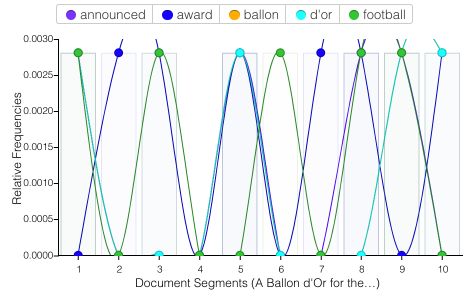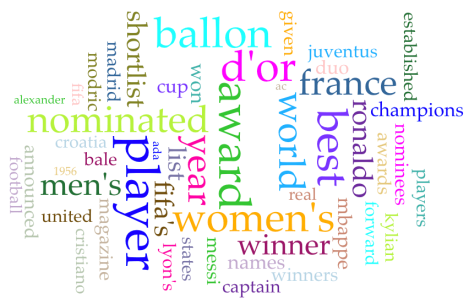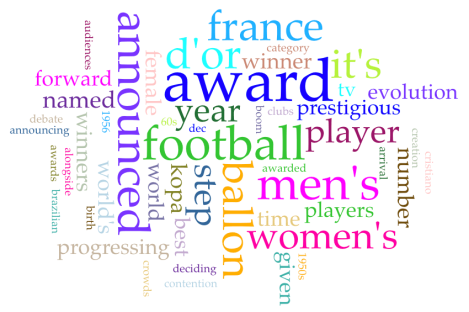By MaryFrances Vorbach
Peer Reviewed By: Connie Polnow and Gillian Hordusky (@conniedhclass @gillianhordusky)
Go check out my visual of this write-up here: https://docs.google.com/presentation/d/1W0BTcL4z0R_vvkNVQlHham3d-oPAZz8RFD1IqvoFrf0/edit?usp=sharing
Soccer is the most popular sport in the world. According to World Atlas, the sport has an estimated global following of 4 billion people. Soccer is a beautiful game full of excitement that is so simple yet so complex. After years of playing, watching, and refereeing soccer, I have grown to love the sport. Now, I am studying and working to have a career in sports media, specifically soccer media. My main focus is on improving the coverage of women’s sports in mainstream sports media. Before improvements can be made, analyzation is crucial. Distant reading is a method that evaluates text to determine what words are the most important by filtering the text. Using Voyant’s distant reading tool that count word usage within specific texts by providing visuals of the results, I analyzed how the same sports media source, ESPN, covered the announcement of the men’s and women’s nominees for the Ballon d’Or—one of the most prestigious individual awards for a soccer player to receive—in two separate articles.
Overview
I believe that analyzation is a crucial part to understanding why media is the way it is and eventually changing it. Without analyzation, there would be no context for decoding the message that is trying to be portrayed. Distant reading is a great tool to use for analyzation because there is an importance on what words are used, and how to decipher what the point of the text is just by looking at the words. Burdick writes, “The recent surge of interest among digital humanists in mapping, for example, is indicative of a trend that recognizes the importance of developing geo-temporal visualizations and mapping platforms to analyze complex social, cultural, and historical dynamics” (18). Using Voyant, I created visual analyzations to help better understand the underlying social dynamics that result in discrepancies between how men and women are covered in the media. Burdick also writes, “digital environments provide the ability to pull together many versions of a single work, tracking its development, noting its variants, and presenting the whole comparative array of witnesses” (35). When using Voyant, sentences with one common word are compared to each other. In this case, Voyant decodes the articles, attempting to determine the main points. Although both articles have the main goal of introducing the nominees for the award, they are different as a result of comparing the contexts of “Ballon” in each article. The men’s article speaks of the award as something a nominee will win while the women’s article speaks of the award as step towards equality.

Context of “Ballon” in women’s article.

Context of “Ballon” in men’s article.
Surprises
When comparing the frequency of words used in both of the articles, I was very surprised at how many of the words were used equally. The word “award” was used six times in the article about the women and five times in the article about the men. Similarly, the name of the award, “Ballon d’Or”, was written four times for the women and five times for the men. It was nice to see that the main focus for both articles was the award, and not specific players or teams. Additionally, I was surprised to see that “men” was mentioned more times than “women” in the article about the women, but “women” was mentioned more times than “men” in the article about the men. I was not expecting the men’s and women’s nominees to be mentioned in both articles, just the men’s nominees in the women’s article.

Relative frequency from the article on the men’s nominees.

Relative frequency from the article on the women’s nominees.
Differences
While the goal of both articles is the same and have a heavy focus on the award, there is one stark difference between the two. When looking at the word graphics, there is a major difference on what is mentioned in the articles. The article on the men’s nominees mentions specific players and teams multiple times. With the inclusion of words such as “Modric”, “Kylian”, “Cristiano”, “Madrid”, “Juventus”, “forward”, and “captain”, the men’s article focuses on the specifics. The use of player and team names as well as player positions indicates the heavy focus on the award and soccer. In comparison, the women’s article does not focus on the details of the nominees. As this year is the inaugural year for the women’s award, the article includes words such as “birth”, “arrival”, “evolution”, “progressing”, and “creation” to explain why this establishment is a small yet important step closer to gender equality in soccer. While the women’s article explaining how the introduction of this award is important, the lack of details on the women is problematic. The name of the clubs the women’s nominees play on should have been mentioned. If the women’s game ever wants to be on the same playing field as the men’s game, then women’s clubs will need to get more popular, and the simple exclusion of the names of clubs these women play on in articles is one thing that does the opposite effect of what product placement in a popular TV show does to help sales.

Word graphic containing frequency of words from the article on the men’s nominees.

Word graphic containing frequency of words from the article on the women’s nominees.
Conclusion
I was intrigued with how ESPN did a decent job at equally covering the nomination announcements for the men’s and women’s Ballon d’Or award. While ESPN has never been good at covering women’s sports as equally as men’s, the quality of their coverage has always been the same for both. For example, I could only find three articles by ESPN about the EUFA Women’s Champions League Final, compared to the dozens on the EUFA Men’s Champions League Final, but a high-quality level of coverage was the same. Distant reading was an integral part of analyzation, proving to be important to understanding reading. Through this practice, I was able to understand how word frequency helps determine the main idea within texts. As a visual learner, having graphs and differing word sizes helped me better understand why words are so important to the message of the texts. This distant reading analyzation proved that, despite the quantity of women’s soccer coverage being significantly less than men’s, the quality of the coverage is at the same level. This analyzation has also proved that there is a discrepancy between the type of detailed coverage. Men’s soccer coverage does not talk about stepping closer to gender equality. Soccer coverage is offside, as men’s coverage is steps ahead of women’s coverage.

